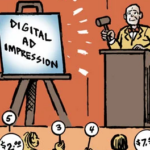 China accounted for more than half of the total global mobile ad spend in Q2 2014.
China accounted for more than half of the total global mobile ad spend in Q2 2014.
We’ll let that sink in for a moment.
From a number like that, it’s little wonder Chinese advertisers and developers are increasing their mobile spend and scaling up their businesses internationally, according to a report released Thursday by app monetization company AppFlood. [Read the report.]
“Chinese advertisers accounted for 60% of global spend [this quarter],” said AppFlood cofounder Si Shen. “As for smartphone penetration in the China market, on the back of more than 420 million smartphone devices projected to be shipped to China in 2014, more mobile users are adopting smartphones as the cost plummets.”
But when we’re talking about smartphones in China, we’re not talking iOS. Apple revenue may be rising in China, but Android has nearly all the smartphone market share. According to an article in the July 12 print edition of The Wall Street Journal, a list of the top vendors by share (all Android except for one notable exception) reads as follows: Samsung (17.8%); Lenovo (11.4%); Coolpad (9.6%); Huawei (8.8%); Xiaomi (8.3%); and Apple (6%). Lenovo, Coolpad, Huawei, and Xiaomi are all Chinese companies.
While smartphone penetration hasn’t hit the majority just yet — according to Google, it’s close at 46.9% — the money is there, said Shen, who noted: “As more eyeballs are being driven to mobile in China, the region’s mobile advertising market is valued at ¥12.56 billion ($2 billion), growing at a rate of 27%.”
Android adoption is increasing so quickly in China for several reasons, among them the fact that all of the big domestic players have built their devices on top of Android technology — and priced them accordingly.
“Apple on the other hand has only sold premium devices, iPhone 5C included, which, when compared to the average Chinese income, is by no means affordable,” Shen said. “At the same time, it was only this year that Apple finally inked its deal with China Mobile, the largest carrier in China. China Mobile subscribers weren’t able to use an iPhone before then.”
The China Mobile deal aside, what Android penetration in China means for advertisers is clear: Apple in China has no reach.
“In general, advertisers prefer iOS over Android because they consider Apple users to be ‘better’ which is probably biased, but still a common belief,” said AdChina CEO Alan Yan. “But over half the market in China is using Android. If you’re a brand and you want to reach as much audience as possible, then you have to go for Android, regardless of how much you might love iOS.”
And though Apple constitutes roughly 6% of the Chinese market, advertisers focusing their spend on iOS probably reach even less than that. Yan theorizes roughly half of Apple phones in China have been unlocked, meaning that three of that 6% are likely running on Android SIM cards.
Another reason Android is making major inroads in China is because of the open nature of its operating system. “There’s a lot of flexibility for developers to run advertising on Android apps as compared to iOS, where Apple controls almost everything,” Yan said.
Advertisers might also be interested to learn that mobile users in China aren’t as unforgiving of mobile advertising as consumers in the US.
“Because smartphone users in China are more relaxed about how their data is used, they’re far more accepting of mobile ads…[and] Chinese mobile users are willing to exchange their personal information for free apps or more relevant ads,” Shen said. “Keep in mind, however, that Google Play is just a small player in China’s app ecosystem, so the restrictions to mobile advertisers in China are not necessarily up to Google Play standards. For instance, app stores in China will allow apps to deliver push notification ads and icon ads, both of which have been banned from the Google Play store.”














